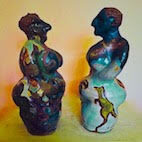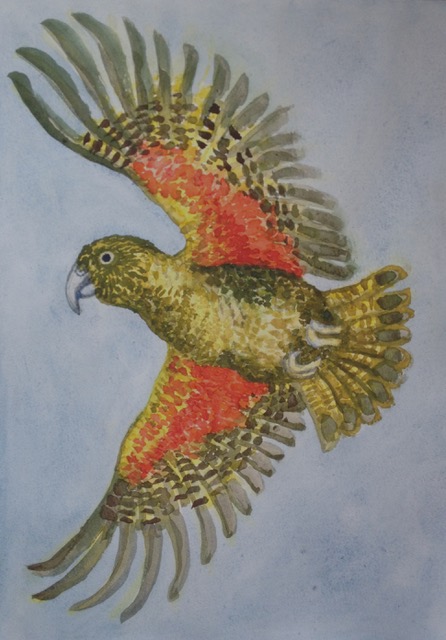The bird flies to enlightenment on two wings: wisdom and compassion. Its eyes are its non-clinging awareness. This is a kea, a New Zealand mountain parrot, who flies in the vast silent spaces of the mountains.
Here are some basic instructions I made for the M.E. society of Oxford. They can be used by anyone who has no chronic illness too.
Monkey mind:
–
Meditation happens in Deep Mind. It uses all the faculties of Deep Mind, not intellect. Intellect is a guide for understanding what’s happening. When you meditate, you’re not thinking about things, you experience it through the body, through your emotions, which are felt through the body. Deep Mind is a very bodily place. It has different levels and many languages. Right brain might be another way of describing what’s happening.
Body awareness is very important. That’s the foundation of the way I teach meditation. Our whole body is where we get enlightened, body and heart, not some other place out in space as many people think.
For visualization, go into Deep Mind, as if you’re dreaming, and let images and feelings arise, as in a dream.
The central thing is to develop awareness of what’s going on. Awareness itself is a deep transformer. It’s non clinging awareness, which simply sees, doesn’t grab onto things or push them away. Just sees the truth of what’s there, the reality from moment to moment. When you go down there in a conscious dreaming state, with awareness, things will transform. There’s a transformation process you can trust.
Instructions
Instructions for meditation are in the practices themselves. I was taught to do that especially by my M.E. group, who couldn’t listen to a lot of talk, so we developed this method.
In the first and second sectionof the Recipe, LIFE, and CARING FOR LIFE, you will find lots of basic instruction in the practices. Most of the meditations in those first two sections are in essence pretty standard Buddhist practices.
How to Do Overview Visioning meditations
The Overview meditations explore what the overview might be, and what it might feel like. This kind of meditation is sometimes called contemplations. They may sound intellectual; the point of doing them as meditations is that we don’t just think about the ideas. We take it to a kinesthetic level and feel what the ideas feel like in the body, and the energy field. We need to incorporate it in our flesh and hearts, to feel the healthy effects of it.
The Transcripts
I’m gradually adding a big resource of transcripts, guided meditations I led in groups and with individuals. Sometimes there are soundtracks too.
When you meditate with these, don’t just read it through. Leave gaps where the dashes are, to explore, contemplate, go deeper.
Each Transcript takes a different approach to the same theme. The transcripts are not set in stone. Each is an exploration. They were done in groups, so it depends who was there on that day and what the needs were. You’re learning to explore these themes for yourself.
Motivation
Your motivation for meditation is really important. The motivation is to awaken, to have insight into the nature of mind, the nature of who we are, and to develop compassion.
There are two aspects of meditation. One is to see the ultimate, the nature of mind, that’s insight; the other is to develop compassion, develop love and various strengths like courage and perseverance, so we can help others in life.
Those are the two wings of the bird that you fly to enlightenment on, with the eyes of awareness between.
Bodhisattva
In Tibetan Buddhism, you’re training to become a bodhisattva, a person who can help, who has the capacity the compassion and the skills to help, such as listening skills, to compassionately listen to people’s pain; the skill of staying calm in the midst of trouble.
I am trained in traditional Tibetan Buddhism. The meditation methods and aims here are in accord with that. I keep a check on myself by studying with traditional Lamas while I develop these methods. They may not look Buddhist; I’ve tried to make them work for modern Westerners.
I’ve also made them so that we can use them for our climate situation and apply them to our lives.

